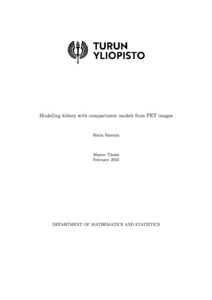Modelling kidney with compartment models from PET images
Rantala, Maria (2022-01-20)
Modelling kidney with compartment models from PET images
Rantala, Maria
(20.01.2022)
Julkaisu on tekijänoikeussäännösten alainen. Teosta voi lukea ja tulostaa henkilökohtaista käyttöä varten. Käyttö kaupallisiin tarkoituksiin on kielletty.
avoin
Julkaisun pysyvä osoite on:
https://urn.fi/URN:NBN:fi-fe2022021419014
https://urn.fi/URN:NBN:fi-fe2022021419014
Tiivistelmä
It is a well established procedure in medical research to analyse tracer activities from PET images and to model certain regions of the body with the help of these measured activities. In this thesis, the PET images are used to examine concentration activity of a tracer in kidney and the behaviour of the concentration activity is modelled with compartment models. One-tissue compartment model has been used before to examine kidney functionality. The focus of this study was to examine the goodness-of-fit of one-tissue compartment model compared to two-tissue compartment model with an additional compartment with irreversible trapping of the tracer. The compartment models were formulated mathematically with the help of Laplace transform and Cauchy's Residue Theorem.
The study had two secondary interests in addition to comparing the two compartment models. The first one was to determine the blood volume value for specific regions of interest in kidney. In short, the blood volume is a model correction that takes in consideration the blood component in the regions of interest. The other secondary interest in the study was delay, which was the time it took the tracer to move from aorta into the regions of interest in kidney. The goal was to see how delay behaved with varying blood volume values.
The study used the PET images of 9 healthy male volunteers. The concentration activities were measured from these images and then compared with the modelled concentration activity values. To determine the most suitable blood volume percentage, 21 fittings were done for both models with fixed blood volume percentages that ranged from 0% to 100% with 5% intervals. The fittings were done with programming language R using a package called kinfitr, which has been created for PET kinetic modelling by Granville Matheson. Slight modifications were made to the code concerning the blood volume value. The fitted values in the models were the K1, k2 and k3 values of the compartment models, the delay and the residual standard error of delay. AIC score and root mean square error were used as the goodness-of-fit measures for the models.
The study had two secondary interests in addition to comparing the two compartment models. The first one was to determine the blood volume value for specific regions of interest in kidney. In short, the blood volume is a model correction that takes in consideration the blood component in the regions of interest. The other secondary interest in the study was delay, which was the time it took the tracer to move from aorta into the regions of interest in kidney. The goal was to see how delay behaved with varying blood volume values.
The study used the PET images of 9 healthy male volunteers. The concentration activities were measured from these images and then compared with the modelled concentration activity values. To determine the most suitable blood volume percentage, 21 fittings were done for both models with fixed blood volume percentages that ranged from 0% to 100% with 5% intervals. The fittings were done with programming language R using a package called kinfitr, which has been created for PET kinetic modelling by Granville Matheson. Slight modifications were made to the code concerning the blood volume value. The fitted values in the models were the K1, k2 and k3 values of the compartment models, the delay and the residual standard error of delay. AIC score and root mean square error were used as the goodness-of-fit measures for the models.
